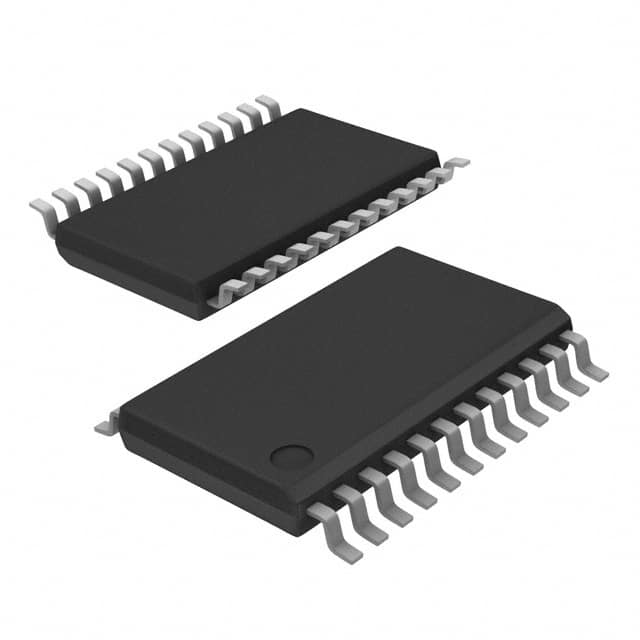Viz Specifikace pro podrobnosti o produktu.

AD7709BRUZ
Product Overview
Category: Integrated Circuit (IC)
Use: Analog-to-Digital Converter (ADC)
Characteristics: - High-resolution ADC - Low power consumption - Serial interface - Programmable gain amplifier - On-chip reference voltage - Flexible input multiplexer
Package: 24-pin TSSOP (Thin Shrink Small Outline Package)
Essence: The AD7709BRUZ is a high-performance ADC designed for precision measurement applications. It offers high resolution, low power consumption, and various features to enhance accuracy.
Packaging/Quantity: The AD7709BRUZ is typically sold in reels of 250 units.
Specifications
- Resolution: 16 bits
- Input Voltage Range: ±Vref
- Conversion Rate: Up to 250 kSPS (Samples per Second)
- Power Supply: 2.7 V to 5.25 V
- Operating Temperature Range: -40°C to +105°C
Pin Configuration
The AD7709BRUZ has a total of 24 pins. Here is the detailed pin configuration:
- AIN1(+) - Positive analog input channel 1
- AIN1(-) - Negative analog input channel 1
- AIN2(+) - Positive analog input channel 2
- AIN2(-) - Negative analog input channel 2
- AGND - Analog ground
- AVDD - Analog power supply
- DVDD - Digital power supply
- DOUT/RDY - Data output or ready signal
- DIN - Serial data input
- SCLK - Serial clock input
- CS - Chip select input
- REFOUT - Reference voltage output
- REFIN(+) - Positive reference voltage input
- REFIN(-) - Negative reference voltage input
- VBIAS - Bias voltage output
- VIO - Digital I/O supply voltage
- DGND - Digital ground 18-24. NC - No connection
Functional Features
- High Resolution: The AD7709BRUZ provides 16-bit resolution, allowing for precise measurement of analog signals.
- Low Power Consumption: With its low power design, the ADC minimizes energy consumption, making it suitable for battery-powered applications.
- Serial Interface: The device features a serial interface for easy integration with microcontrollers and other digital systems.
- Programmable Gain Amplifier: The built-in programmable gain amplifier allows for signal amplification, enhancing measurement accuracy.
- On-Chip Reference Voltage: The ADC includes an on-chip reference voltage source, eliminating the need for external references.
- Flexible Input Multiplexer: The flexible input multiplexer enables the selection of different analog input channels.
Advantages and Disadvantages
Advantages: - High resolution for accurate measurements - Low power consumption for energy-efficient operation - Integrated reference voltage source simplifies circuit design - Programmable gain amplifier enhances measurement accuracy - Flexible input multiplexer allows for versatile signal routing
Disadvantages: - Limited conversion rate compared to some high-speed ADCs - Requires external components for proper operation (e.g., reference voltage)
Working Principles
The AD7709BRUZ operates based on the successive approximation register (SAR) architecture. It converts analog input voltages into digital representations using a combination of sample-and-hold, quantization, and conversion techniques. The internal circuitry ensures accurate and reliable conversion results.
Detailed Application Field Plans
The AD7709BRUZ is widely used in various precision measurement applications, including but not limited to: - Industrial process control - Data acquisition systems - Medical instrumentation - Weighing scales - Temperature measurement devices
Detailed and Complete Alternative Models
- AD7709BNZ: Similar to AD7709BRUZ but in a 28-pin DIP (Dual Inline Package) package.
- AD7709BRMZ: Similar to AD7709BRUZ but with a different pin configuration for surface mount applications.
- AD7790BRUZ: A higher-resolution ADC with 24-bit resolution, suitable for more demanding measurement applications.
These alternative models offer similar functionality and can be considered based on specific application requirements.
Word count: 529 words
Seznam 10 běžných otázek a odpovědí souvisejících s aplikací AD7709BRUZ v technických řešeních
Sure! Here are 10 common questions and answers related to the application of AD7709BRUZ in technical solutions:
Q: What is the AD7709BRUZ? A: The AD7709BRUZ is a high-resolution, low-power analog-to-digital converter (ADC) designed for precision measurement applications.
Q: What is the resolution of the AD7709BRUZ? A: The AD7709BRUZ has a resolution of 16 bits, allowing it to provide precise digital representations of analog signals.
Q: What is the input voltage range of the AD7709BRUZ? A: The AD7709BRUZ has a programmable input voltage range of ±Vref, where Vref can be set between 0.1V and 5V.
Q: Can the AD7709BRUZ handle differential inputs? A: Yes, the AD7709BRUZ supports both single-ended and differential input configurations, providing flexibility in signal conditioning.
Q: What is the maximum sampling rate of the AD7709BRUZ? A: The AD7709BRUZ can achieve a maximum sampling rate of 250 samples per second (SPS), ensuring real-time data acquisition.
Q: Does the AD7709BRUZ have built-in digital filters? A: Yes, the AD7709BRUZ features an on-chip digital filter that can be configured to optimize noise rejection and settling time.
Q: Can the AD7709BRUZ operate in a low-power mode? A: Yes, the AD7709BRUZ offers a low-power mode that reduces the power consumption while maintaining accurate measurements.
Q: Is the AD7709BRUZ compatible with microcontrollers and digital interfaces? A: Yes, the AD7709BRUZ supports various digital interfaces such as SPI and I2C, making it easy to interface with microcontrollers and other digital devices.
Q: Can multiple AD7709BRUZ devices be used in parallel for multi-channel applications? A: Yes, the AD7709BRUZ can be cascaded or used in parallel to enable simultaneous measurement of multiple channels.
Q: What are some typical applications of the AD7709BRUZ? A: The AD7709BRUZ is commonly used in applications such as industrial process control, data acquisition systems, medical instrumentation, and scientific research.
Please note that these answers are general and may vary depending on specific implementation requirements.

